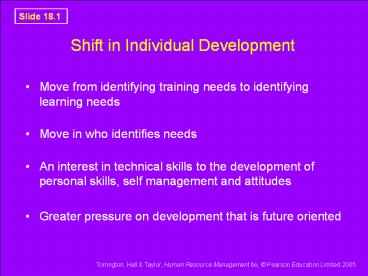Shift in Individual Development PowerPoint PPT Presentation
Title: Shift in Individual Development
1
Shift in Individual Development
- Move from identifying training needs to
identifying learning needs - Move in who identifies needs
- An interest in technical skills to the
development of personal skills, self management
and attitudes - Greater pressure on development that is future
oriented
2
Theoretical Approaches
- Behaviourist approach
- Cognitive approach
- Social learning
- Constructivist perspective
3
Behaviourist Approach
- Earliest approach
- Concentrates on changes in observable behaviour
- Skinner, Watson, and Pavlov
- Behaviour linked to certain rewards/sanctions
4
Behaviourist Approach - Problems
- Trainers are not interested in what is going on
in learners heads - Learners just follow the routine to be learned
- It is overtly manipulative
- It is simplistic and limited
- May produce temporary changes and increases
cynicism
5
Cognitive Approaches
- Based on information processing perspective
- More concerned with whats going on in learners
head - Maps out stages of learning
- Stresses importance of learner motivation and
individual needs, control individual has on
learning, etc
6
Cognitive Approaches - Strengths
- Stresses importance of learner motivation and
needs - Recognises control of learner over what is
learned - Identifies feedback as an important part of
learning
7
Cognitive Approaches - Weaknesses
- Assumes learning is neutral and unproblematic
- It ignores emotion
8
Social Learning Theory
- Learning is a social event
- Based on needs of humans to fit in with others
- Uses role models, mentors and peer support
9
Social Learning Theory - Disadvantages
- Ignores the role of choice for the individual
- It is based to an extent on a masquerade
10
Constructivist Perspectives
- Recognises that learning is very personal and
threatening process - Development of the information processing
perspective - Does not regard learning as a neutral process
- Perception of our experiences that
countInformation and potential learning need to
fit with meaning structures
11
The Learning Cycle
Figure 18.1 The learning cycle
12
Honey Mumford
- Activists
- Reflectors
- Theorists
- Pragmatists
13
Planned Emergent Learning
Table 18.1 Planned and emergent learning Source
Adapted from D. Megginson (1994) Planned and
emergent learning A framework and a method,
Executive Development, Vol. 7, No. 6, pp. 2932.
14
Learning Curves
Figure 18.2 The reality of learning progress
15
A Systematic Model of Learning Training
Figure 18.3 A systematic model of learning and
training
16
Analysing Needs
Problem centred approach Profile comparison
profile approach
17
Problem Centred Approach
- Focuses on performance problems
- Explores whether problems are due to lack of
skills
18
Profile Comparison Approach
- Takes a much broader view
- More useful when someone is new to a job
19
Off-Job Methods of Learning Development
- Educational courses
- In-house courses
- Consultancy courses
- Outdoor type courses
20
Off the Job Methods Transfer of Learning
- Developing goals/plans for implementing new
skills - Reviewing materials immediately after the
programme - Report to peers/supervisors on learning
- Include development goals in performance reviews
21
Learning on the Job
- Manager coaching and teaching
- Mentoring
- Peer relationships
- Action learning
- Self development
- Self development groups
- Learning logs
- Learning contracts
22
Learning Contracts Contents
- An overall development goal
- Specific objectives in terms of skills and
knowledge - Activities to be undertaken
- Resources required
- Method of assessment of learning
23
Open, Distance, and E-learning
CIPD 2003 research One of the most
significant changes in training over the last
five years is the increased use of
e-learning High investment required for
e-learning but cost effective in the long run
providing speedy and flexible training
24
Evaluation of Training Development
- Evaluating the training post course
questionnaire - Evaluating the learning how trainees now behave
- Evaluating changes in job performance
- Evaluating changes in organisational performance
- Evaluating changes in wider contribution
organisation now makes - (Hamblin, 1974)
25
Kilpatricks Evaluation
- Reaction level
- Learning level
- Behaviour
- Results
- (Kilpatrick, 1959)
26
Summary (1 of 2)
- There are four perspectives on learning
- Emphasis moved from training to learning
- Individuals are taking ownership of their own
learning needs - Learners need to understand the nature of
learning and own strengths and weaknesses
27
Summary (2 of 2)
- Emphasis on formal development programmes is
declining - Upsurge in interest in e-learning
- Evaluation of development is critical

